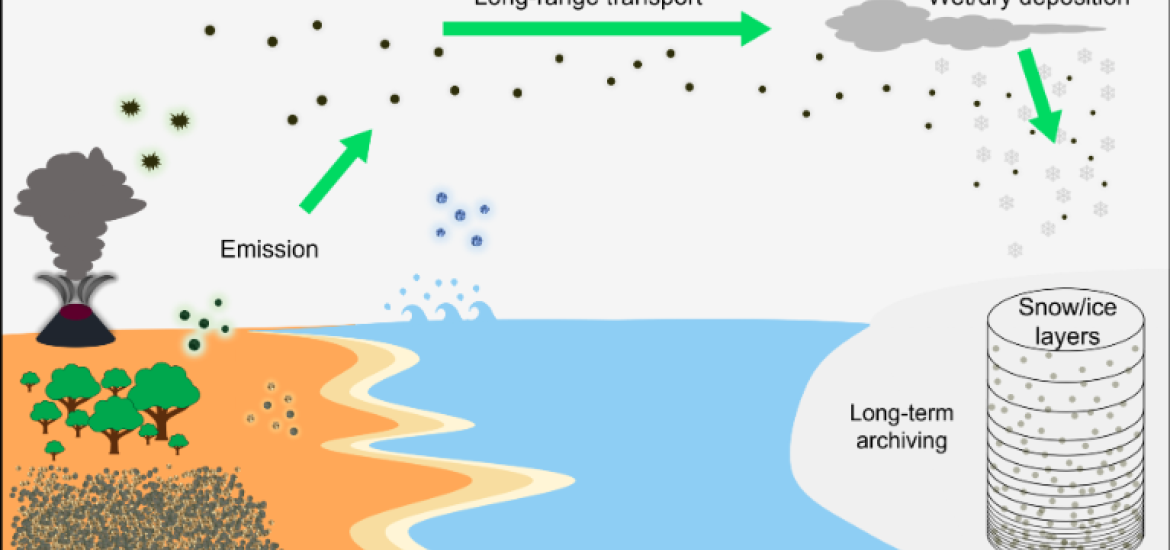- Home
- All News Overview
- Featured Article - Past Global Changes Magazine 31(2): Where Does The Mineral Dust In Greenland Ice Come From?

Wednesday, 13 December, 2023
By Geunwoo Lee, T. Erhardt and H. Fischer
Available in: Past Global Changes Magazine 31(2) "Young scientists at the leading edge of ice-core research"
> Access the contents of this issue
> Download this article as pdf
Where does the mineral dust in Greenland ice come from?
The Asian deserts were identified as the primary source of mineral dust in Greenland ice. However, secondary sources may be overlooked when quantifying contributions of different sources in large bulk samples. Single particle studies can help overcome these limitations.
How mineral dust is archived in Greenland ice
Various types of aerosols are produced in different environments on Earth. For example, volcanoes emit aerosols and precursor gases during their eruptions, oceans generate sea-salt aerosols, and deserts produce mineral dust aerosols (Fig. 1). Among these aerosols, mineral dust plays a crucial role in aerosol composition.
The emission of soil-derived dust into the atmosphere occurs when the wind velocity is high enough to disperse the dust. The threshold wind velocity depends on the particle size, mass, and soil moisture content in the source region. In quantitative terms, the flux of dust generated by the wind is nonlinearly dependent on wind speed (Marticorena and Bergametti 1995). Reconstructing the strength of dust emission from measured ice-core concentrations can help us understand climate change in the source regions.
Many of the major dust sources are located in arid regions of the extratropics due to their dry and windy conditions. This restricted location of dust sources implies that dust must be transported over long distances by atmospheric circulation to reach Greenland. The atmospheric lifetime of dust depends on its size, mass, and the degree of washout by precipitation en route. Thus, climatic changes, such as alterations in atmospheric circulation patterns and precipitation, impact the transport efficiency of dust to Greenland. Long-range transported dust is deposited onto the surface of the Greenland Ice Sheet through both wet and dry processes. Size-dependent dry deposition of aerosols always occurs, whereas wet deposition can only occur if a precipitation event happens on the ice sheet. In summary, for efficient dust export to the Greenland Ice Sheet, dry and windy conditions at the source region and little precipitation en route are necessary (which typically implies transport at high altitudes). Ideally, precipitation over the ice sheet should occur at the time the dust plume reaches Greenland.
Different approaches to determine where the mineral dust came from
Various methods have been used to investigate the sources of dust in Greenland ice. Satellite imagery has been used to observe the transport of dust from its sources to Greenland directly. For example, Prospero et al. (2002) used satellite pictures to identify the desert belt extending from North Africa to Eastern Asia as the primary source of dust in the Northern Hemisphere. Since satellite imagery can only be obtained from cloud-free scanned regions and only for the last few decades, it falls short of providing a comprehensive understanding of the influence of past climate on the sources of dust in Greenland ice.
> Continue reading ...
Figure 1: Life cycle of aerosol components archived in ice cores. Aerosol species are emitted from various sources, such as deserts, vegetation, volcanic activities, and oceans, and then transported over long distances by atmospheric circulation. Aerosols (such as dust) are wet- and dry-deposited en route and onto the ice sheet, and preserved in ice layers.